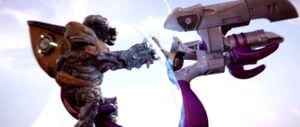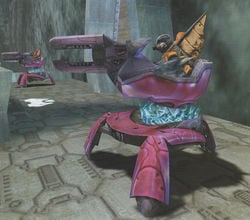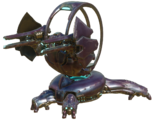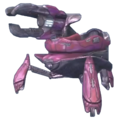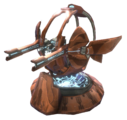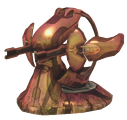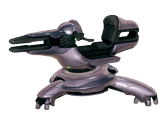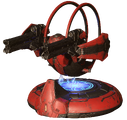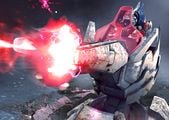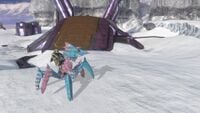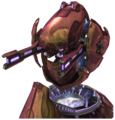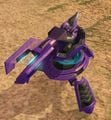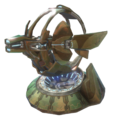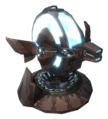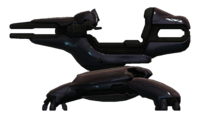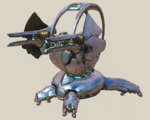Shade
From Halopedia, the Halo wiki
Shades, more formally designated by the Covenant as Gun Pods and by the United Nations Space Command as Anti-Infantry Stationary Guns, are a series of standardised defensive turret emplacements used by the Covenant and its remnants. They consist of manned stationary gun turrets that are easily air-deployable via dropship and are extremely varied in design - with dozens of design pattern variations to account for ever-changing battlefield needs and the ergonomic requirements of the Covenant's client species.[1] Shade variants vary in shape and role, but are similar enough in function and purpose to be grouped into the same category.[2][3]
Shade turrets were once exclusively designed and manufactured by the Assembly Forges of High Charity. After the holy city fell to the Flood and was later destroyed by John-117, Achoem Weapons—based in Tolvuus, Sanghelios—maintains the long-standing tradition of manufacturing the Shade turret.[2]
Design details[edit]
Design details and operation[edit]
The Shades serve as the Covenant's primary stationary gun turrets and are commonly operated by Unggoy. Virtually all models of the Shade offer a wide field of fire by virtue of their mobile turret chassis nestled on a 360-degree traversal anti-gravity mount. The Covenant use this to their advantage and place Shades at strategic points where they can do the most damage, often around their outposts or bases; more permanent facilities are usually also equipped with heavier Kewu Umppi'pa'-pattern citadel turrets. Though most of the Shade models fill an anti-infantry role, anti-vehicle and anti-air variants of the Shade turrets also exist.
Anti-infantry Shade guns fire bolts of slow moving, high-powered plasma encased in magnetic fields. The accuracy of a Shade's weapon is fairly low, as the bolts of plasma fired can hit anywhere within the aiming reticle. The anti-infantry Shade is effective against most infantry. However, due to their high intelligence, Sangheili will often find cover and escape the Shade's range of fire. On this same note, the bolts fired lack the required punch to damage Mgalekgolo, whose armor and combat shield can withstand most Covenant and UNSC small firearms, causing the plasma bolts to have little to no effect on them. It has shown good defense against light vehicles such as the Ghost, and in desperate situations, can serve as anti-aircraft defense, requiring only a few direct hits to destroy a Banshee.
Variants[edit]
Covenant Shade[edit]
Categorising the vast array of Shade design pattern variants has proven a challenge for Office of Naval Intelligence analysts, due to the Covenant's disregard for standardised doctrine. For thousands of years at the empire's height, fleets were simply provisioned with "Shades", with chassis and armaments styles that would be unrecognisable to a modern observer. ONI type-classifications group Shades by the year in which they were first encountered - by contrast, the Covenant's methodology for Shade deployments was ultimately decided by the aesthetic whims of the San'Shyuum official in charge of supplying a given military unit.[2]
- Type-25 Shade - a rarely-seen variant of Shade, and considered by the Office of Naval Intelligence to be a slightly newer variation of the Murien-pattern heavy plasma cannon installed on the Dextro Xur-pattern Spirit dropship.[4]
- Bmur'resh-pattern Shade - a variant based on the Eeo'Pimu-pattern, designed by the Sangheili in the post-war era without the restrictions upon firepower imposed by the San'Shyuum.[1]
- Eeo'Pimu-pattern Shade - a lightweight and portable Shade variant developed for Covenant Special Operations units and fleets serving directly under Hierarchs.[1]
- Mamua'uda-pattern Shade - one of the oldest Shade variants in use, and one especially prized by Covenant commanders due to its antiquity.[1]
- Preksheda-pattern Shade - the most common Shade used during the Human-Covenant War. The Preksheda is a modular and extremely versatile Shade variant, with alternate weapons fittings including anti-armour fuel rod cannons and anti-air rapid-fire plasma cannons.[1]
- Rizsheda-pattern Shade - an alternate variation on the Preksheda, with more focus on gunner protection - though not as commonly used.[1]
- Sho'riru-pattern Shade - a post-war variant most predominantly used by Jul 'Mdama's Covenant, prized for its extraordinary rate of fire and considered to be without equal.[1]
Banished Shade[edit]
A number of Shade offshoots have been designed for use by the Banished.
- Bolroci Workshop Shade - a shade highly based on the Preksheda-pattern design, though with energy shielding installed for gunner protection.
- Shade (Halo Wars 2) - an unidentified model used by Banished forces occupying the Ark.
In-game[edit]
The Shade was first seen in the E3 demo atop a Wuzum-pattern Spectre and made its first gameplay appearance in Halo: Combat Evolved's level, The Truth and Reconciliation. The campaign version of the gun is almost twice as fast as the multiplayer version.
In Halo 3, the Shade's aiming reticule was similar to a Needler's, except with a circle of lines at the center. The Shade was in multiplayer only in Halo 3 Epsilon, as it was removed from the final version, even in Forge. Shades were later made available, free of modding, on some Forge maps.
Neither the Power Drain nor an overcharged Plasma Pistol shot can disable the Shade's firing mechanisms, though either of these will temporarily disable its ability to rotate, this applies to all EMP weapons.
The Shade makes an appearance in Halo Wars and is identical to the Type-29 Shade from Halo: Combat Evolved. Anti-air and anti-vehicle variants of the Type-26 Shade are also introduced in Halo: Reach.
- In Halo: Reach's Forge, the shade turret is the only Covenant vehicle that can be colored based on the team, only changing the base of the turret
Campaign tactics[edit]
- Heavy weapons, vehicles or grenades are perfect to destroy Shades.
- In Halo Combat Evolved, if you get close to a Shade and try to push it, the operator can turn the turret and splatter you with the gun.
- You can also force them to dismount by using explosives to cause the turret to flip.
- In Halo 3: ODST, Automags and snipers can be used to kill the gunner if no heavy weapons can be found.
- Ramming it with any vehicle at speed is an instant kill except in Halo: Combat Evolved and Halo Wars.
- Warthogs and Choppers can ram the turret without injuring the drivers, while Ghosts have a risk of damaging the drivers when ramming.
- In Halo 3 if you shoot a Shade from a distance and in the middle between the two pieces that jut out, the operator might jump out, making them an easier target.
- In Halo 3, if the player stand right in front of the turret, in between the guns, the operator will not turn the turret to make the player slide in front of it, making you a harder target.
- In Halo: Reach, enemies on Legendary can fire the Shade turret at an extreme rate.
- In Halo: Reach, if the player get close to the turret, the operator will jump out of it.
- In Halo: Spartan Assault and Halo: Spartan Strike when a Shade reaches 66% damage, the enemy will dismount from it.
- Note that you cannot score a double kill when you destroy the Shade Turret along with a mounted gunner.
Gallery[edit]
A Mamua'uda-pattern Shade in Halo: Combat Evolved.
An Eeo'pimu-pattern Shade in Halo 2.
Mamua'uda-pattern Shade in Halo Wars
A less-protected variant of the Rizsheda-pattern Shade in Halo 3: ODST
The standard variant of the Preksheda-pattern Shade in Halo: Reach.
A Mamua'uda-pattern Shade in Halo: Combat Evolved Anniversary.
A Sho'riru-pattern Shade in Halo 4.
A Bmur'resh-pattern Shade in Halo 5: Guardians.
A Bolroci Workshop Shade in Halo Infinite.
List of appearances[edit]
Sources[edit]
- ^ a b c d e f g Halo Encyclopedia (2022 edition), page 302-303
- ^ a b c Halo Waypoint, Shade Turret (Retrieved on Sep 30, 2016) [archive]
- ^ Halo: The Essential Visual Guide, page 171
- ^ Halo Waypoint, Spirit (Retrieved on Nov 1, 2020) [archive]
